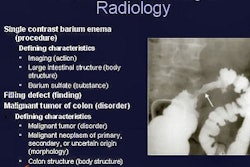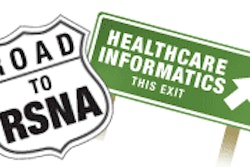Before it implemented a RIS/PACS, the radiology department at Rochester General Hospital in Rochester, NY, struggled to keep up with the workload with its old system of whiteboards, typewriters, lightboxes, and ledgers. But before putting the new systems in place, the department conducted a function-by-function workflow analysis of current practices, laying the groundwork for a successful implementation.
"It was taking 111 hours to get a report out the department," said Pam Moseley, director of RIS/PACS at Rochester General.
Moseley knew the department's processes and procedures had to be brought into the current millennium. She also knew that simply buying technology and throwing it at a problem rarely solved anything. Committing to a proactive approach, Moseley conducted a painstaking function-by-function workflow analysis of current practices before putting her RIS/PACS in place.
"Workflow is key," Moseley said. "If you don't know what your workflow is now, you won't when you put in your RIS/PACS -- and you will fail."
Moseley, along with Stephen Doerner, project manager at Eastman Kodak Health Group, shared insights on their RIS/PACS collaboration at Rochester General with attendees of the American Healthcare Radiology Administrators (AHRA) conference in San Antonio, TX, last month.
"Benchmarking and RIS monitoring bring out some really sore subjects," Doerner said. "Be prepared for some shocking information."
Moseley created a series of teams comprising radiology personnel, administration, information technology, and the vendor. This was further broken out into other teams: a biweekly steering committee that removed adoption barriers, a weekly core team that was comprised of implementers, and ad hoc teams that were created to deal with specific tasks as they arose.
Her overall goal was to automate the department and improve both quality and service. Specifically, she set out to improve ordering, scheduling, imaging, imaging tracking, and results reporting. On the quality side, she set a goal of decreasing report turnaround time and increasing referring physician satisfaction.
"Basically, our goal was to improve the overall department operations," Moseley said.
The group's approach was to create a detailed assessment of the department's current analog workflow, measure the value for specific performance metrics (such as report turnaround time), and compare them to performance by similar institutions.
"But before we measured we asked ourselves: After we go to RIS/PACS will we still have to perform these tasks manually, or will this data be readily available and usable for rapid and easy collection within our new system?" Moseley said.
Working with Doerner, Moseley ensured that each performance element that the team measured would be a function within the RIS/PACS. The group matched what it wanted to measure in the analog workflow against the workflow/report capabilities of the RIS prior to installation -- what matched in both systems they measured.
"Benchmarking current processes provides a metric to establish the improvements delivered by RIS/PACS," Moseley noted.
Analog workflow was captured for 1,389 exams over five days, Doerner said. Analysis of the data took several hundred hours to conduct.
The group decided against using internal personnel to conduct workflow documentation in an effort to achieve a realistic analysis of actual practices.
"It's important to bring someone in from the outside to observe and document workflow," Doerner said.
They videotaped and documented scheduling and registration, reading and dictation, film requests and fulfillment, report review and sign-off, processing and quality assurance, clinical capture, transcription, and archiving. In addition, the team time-stamped these processes, as well as lost film and rebilling information and scheduling call duration.
Moseley and Doerner found that the time spent performing the tasks related to a single exam averaged approximately 35 minutes, but the average cycle time for an exam to be completed (final report distributed) averaged 4.5 days. The review and drop off of the exam averaged 39 hours, the transcription took 63 hours, the read and dictation averaged 8.5 hours, and the exam was approximately one-half hour.
This glaring discrepancy was due to intertask handoff delays, inaccessible information to the staff, and the time delays due to the availability of a single hard-copy image for both radiologists and referring clinicians, according to Moseley and Doerner.
The analog workflow analysis gave the team the opportunity to examine its data for underlying inefficiencies. Each of the procedures conducted by a department is influenced by workflow design, Moseley said.
"Remember these when you attempt to redesign your workflow and create your new measurements," she noted. "Utilize the opportunity to re-engineer your department."
Backlog due to inefficient processes and procedures was crippling the department, so Moseley made the decision to clear it completely before implementing the RIS/PACS.
"Prior to going live, the facility was 2,700 reports behind," she said. "We hired extra staff to clear the backlog so that we could start at zero when the RIS/PACS went live."
The hard work up front has paid off for the radiology department at Rochester General. Its report turnaround time has decreased by 83%, it has seen a 50% improvement in its time from exam completion to dictation, a 98% improvement in the time between dictation and transcription, and a 65% improvement in the time between the end of transcription and report sign-off.
The RIS/PACS implementation has also provided other opportunities for process improvement in areas such as room utilization, scheduling professional staff, revenue capture, and capital purchase requests, Moseley said. She attributes the majority of the success of the systems at the facility to the groundwork conducted prior to its purchase.
"You need to know what you have before you go to buy your RIS," she said.
By Jonathan S. Batchelor
AuntMinnie.com contributing writer
September 16, 2005
Related Reading
Getting the most out of your PACS, August 29, 2005
Service blueprinting maps path to excellence, August 26, 2005
3D navigation holds promise for image overload, July 11, 2005
Structured steps lead to successful RIS purchase/upgrade, June 24, 2005
Web-based workflow and reporting systems keep imaging on track, March 10, 2005
Copyright © 2005 AuntMinnie.com



















